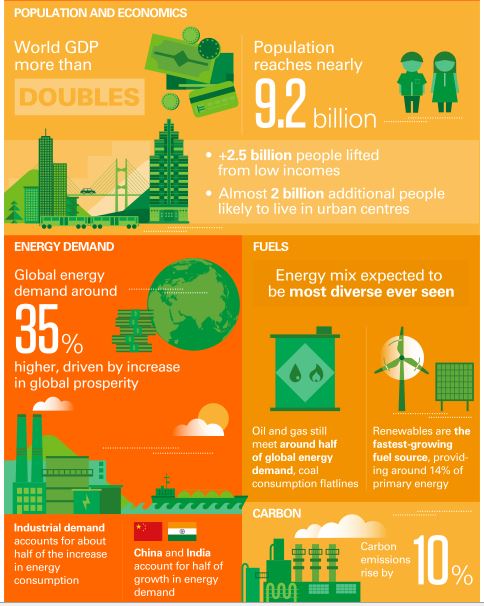BP released its 2018 Energy Outlook Tuesday, this year extending its projections out five additional years to 2040.
BP’s 2018 Outlook’s findings are tied to what it labels ‘the energy transition’.
“The speed of the energy transition is uncertain and the new Outlook considers a range of scenarios. The ‘evolving transition’ scenario assumes that government policies, technologies and societal preferences evolve in a manner and speed similar to the recent past,” BP Group Chief Economist Spencer Dale said.

2018 ENERGY OUTLOOK – FINDINGS
In BP’s evolving transition scenario is aptly named. Because the consumption of energy and the sources that provide it evolve significantly between now and 2040, according to the BP economists.
SOURCES OF DEMAND
- Developing economies step on the gas, pushing up global energy demand by a third.
- China and India each account for about a quarter of the increase in world energy over the Outlook period.
- By moving out to 2040 one thing that emerged was the shift from China to India as the primary driver of global energy demand: by the 2030s, India emerges as the world’s largest growth market for energy.
- Between 2035 and 2040, India’s demand growth is more than 2.5 times that of China, representing more than a third of the global increase.
- Africa’s contribution to global energy consumption also becomes more material towards the end of the Outlook, with Africa accounting for around 20% of the global increase during 2035-2040; greater than that of China.
- The industrial sector accounts for around half of the world’s increase in energy consumption.
- Almost 70% of the increase in primary energy is used for power generation, with power demand growing three times more quickly than other energy.
FUEL MIX
- Renewables account for around half of the increase in electrical power generation and their share of total power generation increases from 7% today to around a quarter by 2040.
- The main loss is by coal, which accounts for just 13% of the increase in power over the Outlook period, compared with more than 40% over the previous 25 years.
- Global coal consumption flatlines: coal’s share of primary energy declines to 21%–the lowest since the industrial revolution.
- Even so, coal remains the largest source of world energy for power in 2040, with a share of almost 30%.
- By 2040, oil, gas, coal and non-fossil fuels each contribute around 25%.
- Natural gas demand grows strongly and gas overtakes coal as the second largest source of energy.
- Demand for oil grows, then plateaus in the later years.
- Oil and gas together account for over half of the world’s energy.
- Renewables increase five-fold and provide around 14% of primary energy.
MOVING PEOPLE AND FREIGHT
- The number of electric cars grows to around 15% but strong usage takes EVs up to 30% of passenger vehicle miles.
- Global demand for both passenger and freight transport services more than doubles by 2040, but the impact on transport fuel demand is largely offset by efficiency gains.
GLOBAL GDP AND ENERGY CONSUMPTION
- Global GDP more than doubles over the Outlook, but energy consumption increases by only 35%.
- Global GDP growth is projected to average around 3 ¼% per annum (at Purchasing Power Parity exchange rates)
- Almost 2 billion additional people are likely to live in urban centers by 2040.
- In Africa the urban population is projected to grow by nearly 600 million – about one-third of the global increase.
- The rise in global output is supported partly by population growth, with the world population increasing by around 1.7 billion to reach nearly 9.2 billion people in 2040.
- But according to BP, the main driver of economic growth is increases in productivity (that is, GDP per person), which accounts for three-quarters of global expansion and lifts more than 2.5 billion people from low incomes.
The 2018 BP ENERGY OUTLOOK is available here.







